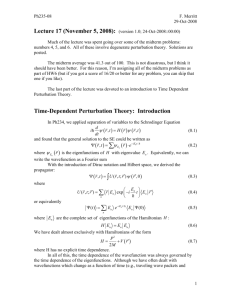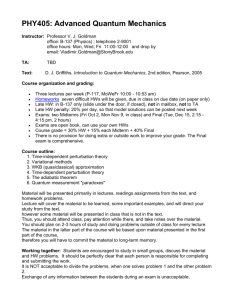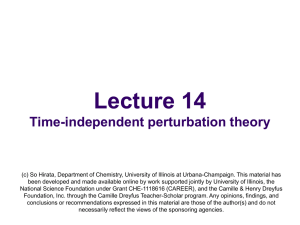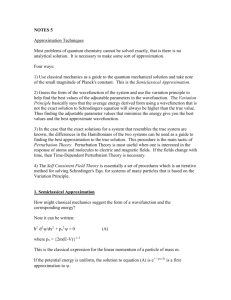402 Review Questions - UBC Physics & Astronomy
advertisement
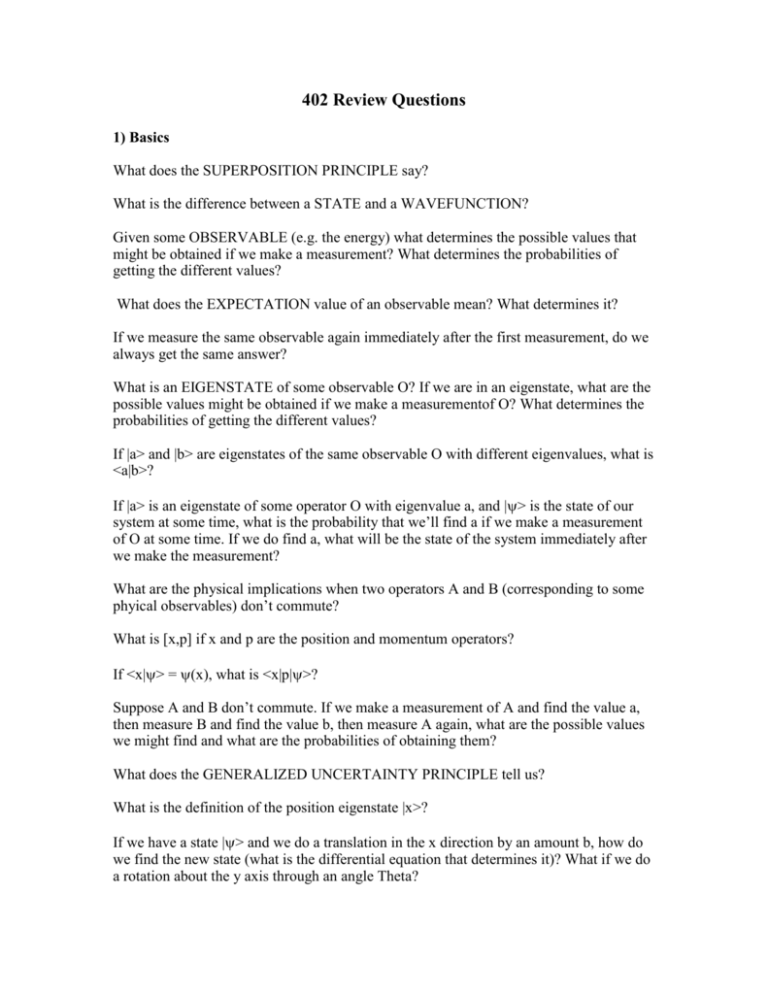
402 Review Questions 1) Basics What does the SUPERPOSITION PRINCIPLE say? What is the difference between a STATE and a WAVEFUNCTION? Given some OBSERVABLE (e.g. the energy) what determines the possible values that might be obtained if we make a measurement? What determines the probabilities of getting the different values? What does the EXPECTATION value of an observable mean? What determines it? If we measure the same observable again immediately after the first measurement, do we always get the same answer? What is an EIGENSTATE of some observable O? If we are in an eigenstate, what are the possible values might be obtained if we make a measurementof O? What determines the probabilities of getting the different values? If |a> and |b> are eigenstates of the same observable O with different eigenvalues, what is <a|b>? If |a> is an eigenstate of some operator O with eigenvalue a, and |> is the state of our system at some time, what is the probability that we’ll find a if we make a measurement of O at some time. If we do find a, what will be the state of the system immediately after we make the measurement? What are the physical implications when two operators A and B (corresponding to some phyical observables) don’t commute? What is [x,p] if x and p are the position and momentum operators? If <x|> = (x), what is <x|p|>? Suppose A and B don’t commute. If we make a measurement of A and find the value a, then measure B and find the value b, then measure A again, what are the possible values we might find and what are the probabilities of obtaining them? What does the GENERALIZED UNCERTAINTY PRINCIPLE tell us? What is the definition of the position eigenstate |x>? If we have a state |> and we do a translation in the x direction by an amount b, how do we find the new state (what is the differential equation that determines it)? What if we do a rotation about the y axis through an angle Theta? If the state of the system at some time t=0 is |>, what determines the state of the system at some later time t=T? If the sytem is in an energy eigenstate |E_n> at time t=0, what is the state of the system at time t=T? If the expectation value of some other observable A is a at time t=0, what is the expectation value at time t=T? What is the relationship between SYMMETRIES and CONSERVATION LAWS in quantum mechanics? 2) The Harmonic Oscillator For a harmonic oscillator with frequency , what are the allowed energies? What is the functional form of the wavefunction for the ground state look like? Qualitatively, what does the wavefunction of the n-th excited state look like? What do the creation and annihilation operators a and a+ do when acting on the n’th eigenstate |n>? What is [a,a+]? What is the Hamiltonian in terms of a and a+? How do we calculate <n|x^2|m>, <n|p^2 x^2|m>, etc... using creation and annihilation operators? 3) Angular Momentum What are the commutation relations between the angular momentum operators J_x, J_y, J_z, and J^2? What are the possible eigenvalues of J^2? For a state with a given J^2 eigenvalue, how many other linearly independent states can we obtain by acting with rotations? For a state |j m>, what do we get if we act with J^2? With J_z? with J_+? With J_-? How do we find the expectation value of J_x or J_y or some function of these (hint: use J_+ and J_)? For example, what is <j m| (J_x)^2 |j m>? If we have a state with two angular momenta in states |j_1 m_1> and |j_2 m_2> how can we determine probability of measuring the system in a total angular momentum state |J M>? What are the possible values for J? What are the possible values for M? 4) Time Independent Perturbation Theory What is time independent perturbation theory good for? If we add a time-independent perturbation H_1 to a system with known non-degenerate energy eigenstates |E_n>, what is the correction to the energy E_n of the n-th state to leading order in perturbation theory? What is the condition that this energy correction is reliable? What is the second order correction to the energy? Hint: to remember the sign, remember that the second order correction to the ground state energy is always NEGATIVE. What is the leading correction to the (unnormalized) wavefunction |E_n>? If initially we have k states |E(1)>,...,|E(k)> with the same energy E, how do we find the energy eigenstates and the shifts in the energies at leading order in perturbation theory? How can we (sometimes) make a choice of basis for the degenerate subspace so that our calculation is as simple as possible? 5) The Hydrogen Atom Ignoring fine structure, what are the energy levels of the hydrogen atom in terms of the ground state energy E_0? What is E_0 (in eV)? What is an eV? How many Joules are in an eV? What is the degeneracy of the n-th level (taking into account electron spin)? What are the possible values of the orbital angular momentum quantum numbers l and m in the n-th eigenstate? Roughly how big (in meters) is a hydrogen atom? What is the origin of the fine-structure, hyperfine structure, and Lamb shift? What is the energy of a magnetic dipole moment in a magnetic field? What is the Hamiltonian for a charged object with spin in a magnetic field? What is the physical origin of the spin-orbit coupling? What is the expectation value of SL in an eigenstate |s=1/2 l j m> of total angular momentum? Taking into account the hyperfine splitting, what are the degeneracies of two lowest energy levels for a hydrogen atom? What is the total angular momentum for these states? Why is there still degeneracy in the hydrogen atom spectrum even after all the corrections are taken into account? What happens to the spectrum when we turn on a magnetic field? What are the two contributions to the resulting perturbation of the Hamiltonian? 5) Identical Particles What are the restrictions on a quantum state describing identical bosons? What are the restrictions on a quantum state describing identical fermions? What does the Pauli exclusion principle say? How does this follow from the restrictions on identical fermion states? What are exchange forces? 6) The Variational Principle What is the variational method good for? Given some Hamiltonian H, and a trial state |>, what can we say about <|H|>? What is an effective way to use the variational method in practice (so that we don’t just consider one trial wavefunction at a time)? 7) The WKB Approximation What is the WKB approximation good for (give 2 applications)? When is the WKB approximation effective for determining bound state energies? What is wavefunction for a particle in a constant potential V? What is the form of the WKB wavefunction in a region where E>>V? Given some potential V(x) , what equation determines the WKB energies in the case where the potential has smoothly sloping sides? When one or both sides are sharp? For a 1D particle incident on a high/wide potential barrier, what is the WKB approximation to the transmission probability? 8) Time dependent perturbation theory What is time-dependent perturbation theory good for? If we are in some eigenstate | E_a> of H_0 at time t=0, and turn on some perturbation H’(t), what is the probability that we’ll measure the system in another eigenstate |E_b> of H_0 if we make a measurement at time t=T (in first order time-dependent perturbation theory)? What is the total probability P(t) of making a transition? How can we tell if our perturbation theory is valid? What are ABSORPTION, STIMULATED EMISSION, and SPONTANEOUS EMISSION? If we begin in a state |a>, at what frequency of incident radiation is it most likely that we’ll have a transition to some other state |b>? In the dipole approximation, what quantum mechanical matrix element determines the rate for transitions between two states |_a> and |_b> of an atomic system? How does the rate depend on this matrix element? For absorption or spontanoeus emission due to incoherent radiation, what else does the rate depend on? What is the LIFETIME of a state and how do we calculate it? What determines whether a given transition is allowed in the dipole approximation? What physical effects are reponsible for the fact that experimentally observed spectral lines have some thickness? 9) Charged Particles in Electromagnetic Fields What is the Hamiltonian for a charged particle in an electromagnetic field, specified by vector and scalar potentials A and ? What is gauge invariance? For an monochromatic electromagnetic plane-wave, what is the time-dependence of the electric field at a given point in space? 9) Adiabatic Approximation What does the adiabatic theorem tell us? If we slowly vary the parameters of the Hamiltonian, can the energy of a state change? What is it that remains constant? What happens to the wavefunction if the Hamiltonian undergoes a very sudden change? 10) Scattering Qualitatively, what are we trying to measure in a scattering experiment? What are the definitions of LUMINOSITY, DIFFERENTIAL SCATTERING CROSS SECTION, and TOTAL CROSS SECTION? What it the total cross section in a classical scattering experiment with a fixed solid target? Given some weak potential, how do we compute the differential scattering cross section in the Born Approximation (you don’t need to remember the constants here)? If we scatter electrons from a fixed potential, what quantities (that we can vary in our experiment) will the differential scattering cross section depend on?

